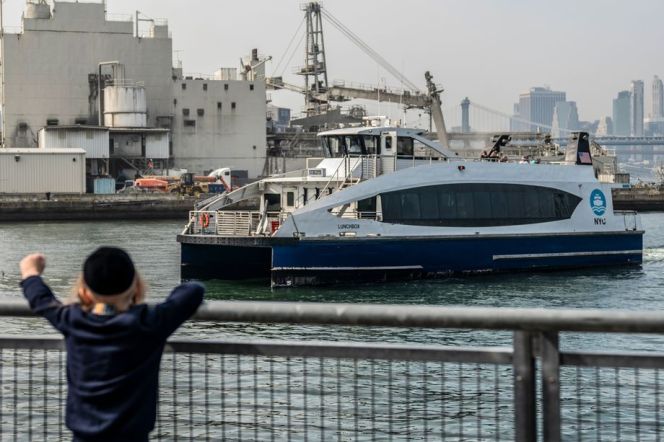What City Observatory did this week
The folly of the frog ferry. One bane of transportation policy discussions is the tendency to believe that miracle technical fixes—self-driving cars, personal aircraft, the Segway, or Elon Musk’s car tunnels–are going to overcome the physics, geometry and economics that make transportation a hard problem. The latest iteration of this fixation is in Portland, where water transport advocates have been pushing for a “Frog Ferry” to connect Vancouver Washington and Portland Oregon. Ferry promoters have a clever video, asking people to imagine a faster trip by boat, but the trouble is ferries are competitive with either private cars, or importantly, existing transit buses. There is a river route, but it turns out to be roughly twice as long as traveling by the roadway.
An even the fastest water ferries can’t ply the distance between the two cities as quickly as today’s buses running mixed traffic. In fact, the ferry’s likely to be 20 minutes slower than the 40 minute bus ride, and leave you at the riverside, rather than near your destination. A slow boat to nowhere isn’t going to be a competitive mode of transportation in the Rose City.
Must read
The hidden cost of “free” transit. There’s a decided inequity in the way we finance urban transportation. Almost everywhere, its free to store private vehicles in the public right-of-way. But in most cases, you can’t set foot on a public bus without paying a fare for each trip. Little surprise that eliminating transit fares seems like a good way to rectify this inequity and it seems like a great way to entice people out of cars, reducing driving and pollution.Writing at Bloomberg, David Zipper challenges this notion, saying that the real world evidence on this environmental benefit is weak:
After more than a decade of transit agencies around the world experimenting with free trips, it’s far from clear that dropping fares delivers an environmental upside. It boils down to this: If fare-free transit doesn’t substantially reduce driving, it’s not mitigating emissions or slowing climate change. And all signs suggest that it doesn’t.
And in a world of limited resources for transit, eliminating fare revenue reduces the resources needed to pay drivers, and fewer driver hours means less transit service. When transit service provides value for money (access to important destinations and good frequency) riders are happy to pay. Free service that comes less often is not a good deal for them, or a benefit to the environment. And perhaps the best way to promote greater equity and reduce driving would be to ask cars to pay their way.
A YIMBY Victory in San Francisco. The deep blue bastion of San Francisco may seem like an unlikely place for political trend spotting, but a special election runoff for a vacant State Assembly seat signals an important shift. KQED reports that the race pitted two long time San Francisco Supervisors—Matt Haney and David Campos. Both are strong progressives, but the issue that separated the two was YIMBY v. NIMBY. Haney has supported a wide range of efforts to expand housing supply; Campos has spoken out in favor of affordable housing, but voted against proposals that expand market rate housing. For many San Francisco voters, however, housing has become a dividing line between the two candidates. In a bid to drive down the city’s sky-high rents, Haney has consistently advocated for an increase in overall housing construction, while Campos has pushed to prioritize affordable developments over anything else . The city approved more than 2,000 housing units per year in Haney’s district, compared to fewer than 200 per year in Campos’s district.
Krugman: Celebrate Earth Day by making it easier to build housing in cities. San Francisco’s special election caught the eye of New York Times columnist and economist Paul Krugman, who singled out housing issue and its national implications. If the YIMBY victory in San Francisco foreshadows a national shift, he says, the implications could be positive. Not only are cities greener (people use less energy and create fewer greenhouse gases heating and cooling buildings and driving), but cities are more productive. And our failure to build enough housing to meet demand for urban living is a key driver of our national and local housing affordability problems. As Krugman notes:
. . . cities have become highly desirable places to live and work . . . but they’ve become increasingly unaffordable, largely because of local-level opposition to new construction. . . .
Allowing greater density, Krugman argues:
“. . . would be good for the economy. Some people are willing to pay very high prices for urban housing because they’re more productive in big cities. So limiting density makes America poorer by preventing workers from making the best use of their talents.”
New Knowledge
The rise in E-Commerce during the pandemic. The Census Bureau released its latest estimates of total US retail sales for 2020, and unsurprisingly, they show the sharp rise in e-commerce during the Covid-19 pandemic. Total US retail sales surges to about $5.6 trillion in 2020, and e-commerce sales made up about $815 billion or 14 percent of the total.
Of course, the pandemic produced wide variations in retail sales trends across different sectors of the economy. Sales at food stores increased noticeably, while sales for gas stations, clothing stores and electronics and appliance retailers all fell by double-digit amounts. E-commerce rose 43 percent year over year from 2019 through 2020.
US Census Bureau, Annual Retail Trade Survey (ARTS), 2020. https://www.census.gov/programs-surveys/arts/data/tables.html


